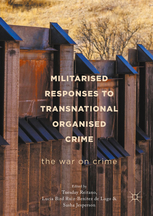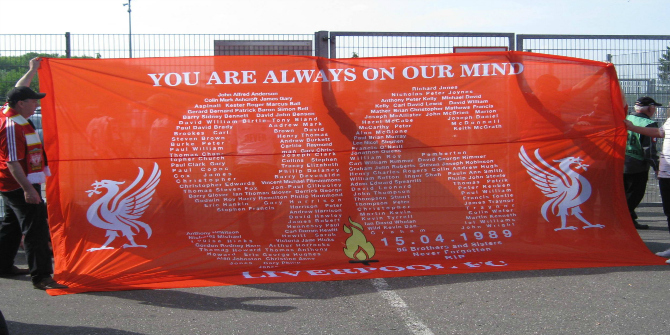In Militarised Responses to Transnational Organised Crime: The War on Crime, Tuesday Reitano, Lucia Bird Ruiz-Benitez de Lugo and Sasha Jesperson offer a collection addressing the issue of militarisation in the context of illicit wildlife trafficking, maritime piracy, human smuggling and drug dealing. Examining the many faces of militarisation and the controversies surrounding its use, this is a valuable and thought-provoking contribution to the literature, finds Anton Moiseienko, full of high-quality essays that are rich in detail.
Militarised Responses to Transnational Organised Crime: The War on Crime. Tuesday Reitano, Lucia Bird Ruiz-Benitez de Lugo and Sasha Jesperson (eds). Palgrave Macmillan. 2018.
Ensuring the security of its citizens is one of the essential functions of the modern state. Organised crime puts public safety at risk and impedes the performance of other vital state functions, such as taxation and border control. Whilst law enforcement agencies typically bear the primary responsibility for crime detection and prevention, in extreme cases it is easy to see the attractions of a more heavy-handed, military-led approach to restoring public order.
Originating in two workshops held in London and Geneva in 2015 and 2016, Militarised Responses to Transnational Organised Crime: The War on Crime is an edited collection of nineteen essays that addresses the issue of militarisation in the context of four types of transnational organised crime: illicit wildlife trafficking; maritime piracy; human smuggling; and drug dealing.
To say such about a book may be a cliché, but this volume is genuinely thought-provoking. The chapters are of consistently high quality and rich in detail, although nit-picking readers will find enough typos to keep themselves amused. As is also the case with good edited collections, individual contributions complement each other and stimulate reflection on the book’s central theme.
The choice of the four areas that the book focuses on is not explained in great detail, but works remarkably well. Illicit wildlife trafficking and piracy are crimes that involve violence, whether against humans or animals, and require the policing of wide areas to the point that this stretches resources and puts a strain on the credibility of governments. Parallels are immediately apparent between one ranger guarding 47 square kilometres of South African nature reserves under the assumption that they work 24/7 (see Julian Rademeyer’s chapter, page 47) and the explanation by Major General Howes, the head of the European Union’s anti-piracy maritime force off the coast of Somalia, EUNAVFOR, that ‘the locus of a modern warship on the scale of [the] map and what it can actively survey and influence in an hour is about a pinprick’ (Glen Forbes’s chapter, page 116).
Human smuggling presents similar challenges, at least from the standpoint of EU countries who seek to police large sea areas to stem the mass influx of refugees through the Mediterranean. However, unlike the anti-piracy missions in Somalia whose objective was to protect merchant vessels from pirate attacks, anti-smuggling measures aim to protect state borders from unauthorised crossings, which is an even greater challenge than fending off piracy (Tuesday Reitano’s chapter, page 344). Like other types of crimes considered in the book, drug dealing is also invariably transnational, with the result that numerous states along the supply chain have the incentive to adopt policies that insulate their country from the threat, without necessarily cooperating to stem drug production in source countries, as discussed by Sasha Jesperson.
 Image Credit: USS Chosin, Gulf of Aden, 2010 (DVIDSHUB CC BY 2.0)
Image Credit: USS Chosin, Gulf of Aden, 2010 (DVIDSHUB CC BY 2.0)
Most importantly, however, all four types of crime considered in the book have been or are combated by means of engaging military forces to aid law enforcement agencies. The general mood of the authors is cautious scepticism towards the utility of militarised responses against organised crime, although there is considerable divergence of opinion. The overall suspicion against military engagement is perhaps unsurprising. For it ever to be justified, the scale of criminality must be beyond the control of ordinary law enforcement agencies. However, widespread criminality is likely to be symptomatic of endemic poverty, corruption and the general disintegration of governance structures, so that military responses can only be a short-term prelude to more sustainable solutions. Against this background, there is much force in Reitano’s conclusion that only a bespoke combination of security-led and development-led approaches is likely to achieve success (340). In like vein, Anja Shortland questions whether the international military response to Somali piracy was a victim of its own success by removing, for the time being, the incentive to address the factors that might contribute to its resurgence in the future. Taking the example of Kenya, Jasper Humphreys and M.L.R. Smith highlight further challenges that arise when state military resources are directed towards the protection of the land that belongs to local elites (35).
The contributors all appear to proceed from the same premise that anti-crime interventions should therefore aim to achieve a long-term reduction of crime-related societal harm while respecting human rights. However, they do not speak with one voice, and different emphases are placed throughout the book. The chapter on piracy in West and Central Africa by Ian Ralby as well as that on South-East Asian piracy by Karsten von Hoesslin and Lucia Bird Ruiz-Benitez de Lugo, are relatively sympathetic to military solutions, but discuss how they should be tailored to local realities without blindly emulating the policies that were successful in Somalia. On the other hand, the contributions by Brian Erickson, Sumbul Rizvi and Health Poverty Action, a UK-based NGO, are heavily human rights-focused and caution against the potential for abuse that militarisation brings.
Interestingly, the book’s two leitmotifs – the need for development-led approaches and the potential for abuse inherent in militarisation – disclose its limitations. These are intentional and do not detract from the volume’s value. As noted in Reitano’s concluding chapter, most works on transnational crime are sectoral in that they focus on particular forms of crime (339). In contrast, Militarised Responses to Transnational Organised Crime examines in detail a method (militarisation) that has been employed in numerous settings with varying degrees of success. However, it is precisely the former, context-specific approach that is key to effective policymaking. The present book will therefore not serve as a comprehensive guide to solving any of the problems that it skillfully examines, but it certainly points policymakers and academics in the right direction.
Similarly, the discussion of how ‘militarised responses’ can be abused reflects what is arguably a broader issue affecting any type of law enforcement operation. Mark Shaw’s chapter elucidates the many faces of militarisation, from ‘war talk’ to the actual deployment of military assets, and notes that even civilian agencies may ‘adopt tactics and operational styles that are military or paramilitary in nature’ (13). This is precisely the subject of Brian Erickson’s account of the US Customs and Border Protection, and an option that Colombia, Mexico and Honduras have opted for in the war on drugs (Jeremy McDermott’s chapter, page 271). While the human rights record of some such agencies is not spotless, it is arguably not militarisation as such that gives rise to problems including the abuse of power or corruption, but rather factors including the lack of adequate oversight or dysfunctional organisational cultures.
Much of the well-founded critique voiced by the book’s contributors thus applies to law enforcement in general. This is revealed in Thomas Maguire’s description of the resentment of local Kenyan NGOs towards the collection of massive amounts of personal data by authorities to secure parks and conservancies (6). The issues of accountability and human rights therefore arise regardless of whether it is the military or civilian agencies that conduct the surveillance. John Sellar’s pragmatic prescription for governments to shape their interventions in light of the ‘capacity and expertise of national agencies’ (103), whether military or law enforcement, is hence to be commended.
It is fair to say, therefore, that Militarised Responses to Transnational Organised Crime raises some fundamental questions that need to be addressed in order to design effective responses to transnational organised crime. Among them are the balance between development initiatives and military or law enforcement interventions, as well as the need to only adopt measures that are limited and proportionate, with necessary accountability mechanisms in place. These issues are more than a single book can examine in detail, but by highlighting the controversial aspects of militarisation as a response, this book has made a valuable contribution to the existing literature on transnational organised crime.
Anton Moiseienko has completed his PhD in law at Queen Mary University of London where his research focused on international policies against corruption. He is now a research analyst at the Royal United Services Institute. The views expressed in this review are his own. Read more by Anton Moiseienko.
Note: This review and interview gives the views of the author, and not the position of the LSE Review of Books blog, or of the London School of Economics.


 Find this book:
Find this book: 



